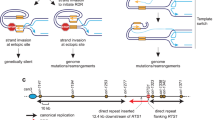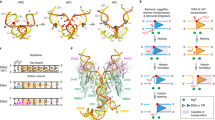Abstract
The heteroduplex joint, a splice containing paired strands from each of two DNA molecules is a key feature of homologous genetic recombination1,2. The formation of such a lap joint ensures that heterologous chromosomes do not recombine; presumably the degree of homology determines the frequency of crossing over between related but non-identical chromosomes. On the other hand, according to the current ideas on recombination, the formation of heteroduplex joints is not a stringent process. Genetic evidence supports the view that the classical phenomena of meiotic gene conversion and aberrant meiotic segregation result in part from the inclusion of mismatched base pairs in heteroduplex joints, and the subsequent correction of some of these mismatched pairs before replication3–5. Thus meiotic gene conversion signals one kind of departure from perfectly faithful pairing. The association of increased mutation frequencies with crossing-over is another kind of departure from fidelity in recombination6–8. Little is known about the effect of imperfect homology either on the initial pairing of DNA molecules, or on the formation and extension of heteroduplex joints. The nucleotide sequences of phages 3ΦX174 and G4 are related, but differ by 33% of bases in the coding regions. Here we show using combinations of 3ΦX174 and G4 DNA, that Escherichia coli RecA protein catalyses the formation of joint molecules with many mismatched base pairs, but only if one of the molecules is superhelical. By contrast, in the absence of RecA protein, superhelicity does not cause ΦX174 and G4 DNA to form D-loops spontaneously at any temperature between 37 and 75°C. These observations focus attention on the role of RecA protein in unwinding DNA, and on superhelicity as a factor that can lessen the fidelity of homologous pairing.
This is a preview of subscription content, access via your institution
Access options
Subscribe to this journal
Receive 51 print issues and online access
$199.00 per year
only $3.90 per issue
Buy this article
- Purchase on Springer Link
- Instant access to full article PDF
Prices may be subject to local taxes which are calculated during checkout
Similar content being viewed by others
References
Fox, M. S. A. Rev. Genet. 12, 47–68 (1978).
Radding, C. M. A. Rev. Biochem. 47, 847–880 (1978).
Stadler, D. R. A. Rev. Genet. 7, 113–127 (1973).
Fogel, S., Mortimer, R., Lusnak, K. & Tavares, F. Cold Spring Harb. Symp. quant. Biol. 43, 1325–1341 (1978).
Rossignol, J-L., Paquette, N. & Nicolas, A. Cold Spring Harb. Symp. quant. Biol. 43, 1343–1352 (1978).
Magni, G. E. & Von Borstel, R. C. Genetics 47, 1097–1108 (1962).
Magni, G. E. Proc. natn. Acad. Sci. U.S.A. 50, 975–980 (1963).
Strigini, P. Genetics 52, 759–776 (1965).
Clark, A. J. A. Rev. Genet. 7, 67–86 (1973).
Kobayashi, I. & Ikeda, H. Molec. gen. Genet. 166, 25–29 (1978).
DasGupta, C., Shibata, T., Cunningham, R. P. & Radding, C. M. Cell 22, 437–446 (1980).
Cunningham, R. P., Wu, A. M., Shibata, T., DasGupta, C. & Radding, C. M. Cell 24, 213–223 (1981).
DasGupta, C., Wu, A. M., Kahn, R., Cunningham, R. P. & Radding, C. M. Cell 25, 507–516 (1981).
Kahn, R., Cunningham, R. P., DasGupta, C. & Radding, C. M. Proc. natn. Acad. Sci. U.S.A. 78, 4786–4790 (1981).
DasGupta, C. & Radding, C. M. Proc. natn. Acad. Sci. U.S.A. (in the press).
Cox, M. M. & Lehman, I. R. Proc. natn. Acad. Sci. U.S.A. 78, 3433–3437 (1981); Proc. natn. Acad. Sci. U.S.A. 78, 6018–6022 (1981).
Shibata, T., DasGupta, C., Cunningham, R. P. & Radding, C. M. Proc. natn. Acad. Sci. U.S.A. 76, 1638–1642 (1979).
McEntee, K., Weinstock, G. M. & Lehman, I. R. Proc. natn. Acad. Sci. U.S.A. 76, 2615–2619 (1979).
Beck, E. et al. Nucleic Acids Res. 5, 4495–4503 (1978).
van Wezenbeek, P. M. G. F., Hulsebos, T. J. M. & Schoenmakers, J. G. G. Gene 11, 129–148 (1980).
Godson, G. N., Fiddes, J. C., Barrell, B. G. & Sanger, F. in The Single-Stranded DNA Phages (eds Denhardt, D. T., Dressier, D. & Ray, D. S.) 51–86 (Cold Spring Harbor Laboratory, New York, 1978).
Godson, G. N. in The Single-Stranded DNA Phages (eds Denhardt, D. T., Dressier, D. & Ray, D. S.) 671–695 (Cold Spring Harbor Laboratory, New York, 1978).
Cunningham, R. P., DasGupta, C., Shibata, T. & Radding, C. M. Cell 20, 223–235 (1980).
Radding, C. M., Beattie, K. L., Holloman, W. K. & Wiegand, R. C. J. molec. Biol. 116, 825–839 (1977).
Beattie, K. L., Wiegand, R. C. & Radding, C. M. J. molec. Biol. 116, 783–803 (1977).
Cunningham, R. P., Shibata, T., DasGupta, C. & Radding, C. M. Nature 281, 191–195 (1979); 282, 426 (1979).
Author information
Authors and Affiliations
Rights and permissions
About this article
Cite this article
DasGupta, C., Radding, C. Lower fidelity of RecA protein catalysed homologous pairing with a superhelical substrate. Nature 295, 71–73 (1982). https://doi.org/10.1038/295071a0
Received:
Accepted:
Issue Date:
DOI: https://doi.org/10.1038/295071a0
This article is cited by
-
The barrier to recombination between Escherichia coli and Salmonella typhimurium is disrupted in mismatch-repair mutants
Nature (1989)
-
Molecular fate of heterologous bacterial DNA in competent Bacillus subtilis: Further characterization of unstable association between donor and recipient DNA and the involvement of the cellular membrane
Molecular and General Genetics MGG (1984)
Comments
By submitting a comment you agree to abide by our Terms and Community Guidelines. If you find something abusive or that does not comply with our terms or guidelines please flag it as inappropriate.



